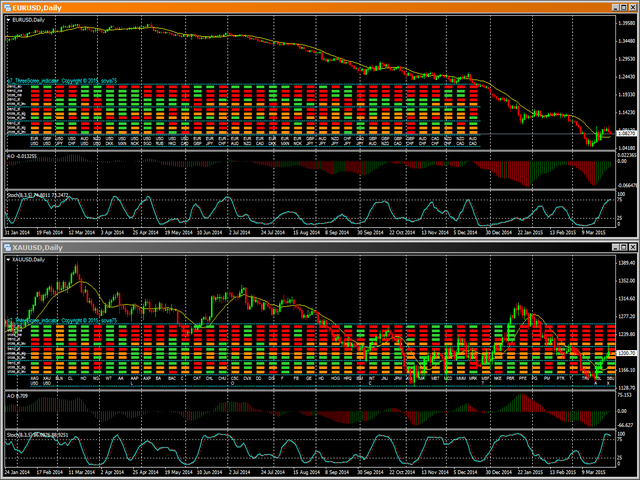The indicator is designed for manual multi-currency trading using the Three Elder Screens system.
The indicator works with any symbols located in the MT5 Market Overview window – currencies, metals, indices, etc. (only one tool is available for the demo version – NZDCAD!)
The full version can be downloaded from the MultiSymbol Triple Screen Trading System MT5 link.
The indicator uses a modified Three-Screen system, which determines the trend direction on the third screen using the Awesome Oscillator, Moving Average, and Stochastic Oscillator indicators of the trader’s choice. At the second level, the oversold/overbought level is determined by the Stochastic indicator. At the first stage, the Stochastic indicator is used again, but this time to determine the best entry point to the market. As a result, we get rid of the need to move pending orders behind the market (which is provided by the classical system), and we can immediately enter the market.
The indicator will be of interest to those who prefer multi-currency trading.
When working with the Three Elder Screens system, you need to analyze three time periods for each instrument. And to work with a large number of tools, it takes a very long time. To facilitate this work, this indicator was created. It independently analyzes all the selected instruments for three time periods and, when finding the desired combination of parameter values, warns the trader about the possibility of making a trade.
[spoiler title=”Read More…”]
The trader only needs to set in the settings what parameters the indicator will use to check the instruments for the possibility of making a trade.
The indicator informs the trader about the possibility of making a trade by displaying a pop-up message on the screen, sending a message to an email, to a mobile terminal, or simply playing an audio file.
The indicator works with current prices (uses a zero bar).
To reduce the load on the processor, it is possible to configure the redrawing period of the indicator indicators.
- Indicator_Position / indicator position
- myPosition – the position of the indicator in the main chart window (bottom left, bottom right)
- Visible_Symbols / visible tools
- Symbols-enter tracking tools (separated by commas, without spaces)
- Third_screen_Settings / settings for the third screen
- ThTrendAO – trend direction based on the AO indicator on the third screen (use/not)
- ThTrendMA – trend direction based on the MA indicator on the third screen (use/not)
- ThCrossMA – finding the price above/below the MA indicator line on the third screen (use/not)
- ThTrendSt – trend direction based on the Stochastic indicator on the third screen (use/not)
- ThCrossStLev-finding the main indicator of the Stochastic indicator above/below the overbought/oversold level on the third screen (use/not)
- ThTF – time period on the third screen
- Second_screen_Settings / settings for the second screen
- SeTrendSt – trend direction based on the Stochastic indicator on the second screen (use/not)
- SeCrossStSig-the main line of the Stochastic indicator crosses the signal line on the second screen (use/not)
- SeCrossStLev-finding the main indicator of the Stochastic indicator above/below the overbought/oversold level (use/not)
- SeTF – time period on the second screen
- First_screen_Settings / settings for the first screen
- FiTrendSt – trend direction according to the Stochastic indicator (use/not)
- FiCrossStSig-the main line of the Stochastic indicator crosses the signal line (use/not)
- FiCrossStLev-finding the main indicator of the Stochastic indicator above/below the overbought/oversold level (use/not)
- FiTF – time period on the first screen
- …
- myPosition – the position of the indicator in the main chart window (bottom left, bottom right)
- Symbols-enter tracking tools (separated by commas, without spaces)
- ThTrendAO – trend direction based on the AO indicator on the third screen (use/not)
- ThTrendMA – trend direction based on the MA indicator on the third screen (use/not)
- ThCrossMA – finding the price above/below the MA indicator line on the third screen (use/not)
- ThTrendSt – trend direction based on the Stochastic indicator on the third screen (use/not)
- ThCrossStLev-finding the main indicator of the Stochastic indicator above/below the overbought/oversold level on the third screen (use/not)
- ThTF – time period on the third screen
- SeTrendSt – trend direction based on the Stochastic indicator on the second screen (use/not)
- SeCrossStSig-the main line of the Stochastic indicator crosses the signal line on the second screen (use/not)
- SeCrossStLev-finding the main indicator of the Stochastic indicator above/below the overbought/oversold level (use/not)
- SeTF – time period on the second screen
- FiTrendSt – trend direction according to the Stochastic indicator (use/not)
- FiCrossStSig-the main line of the Stochastic indicator crosses the signal line (use/not)
- FiCrossStLev-finding the main indicator of the Stochastic indicator above/below the overbought/oversold level (use/not)
- FiTF – time period on the first screen
- green – buy signal;
- red – signal for sale;
- orange – neutral signal;
- gray-this option is disabled.
An example of trading using this indicator is shown in the images below.
The indicator was specially developed for participation in the competition of traders using manual trading on the system of Three Elder Screens.
[/spoiler]





